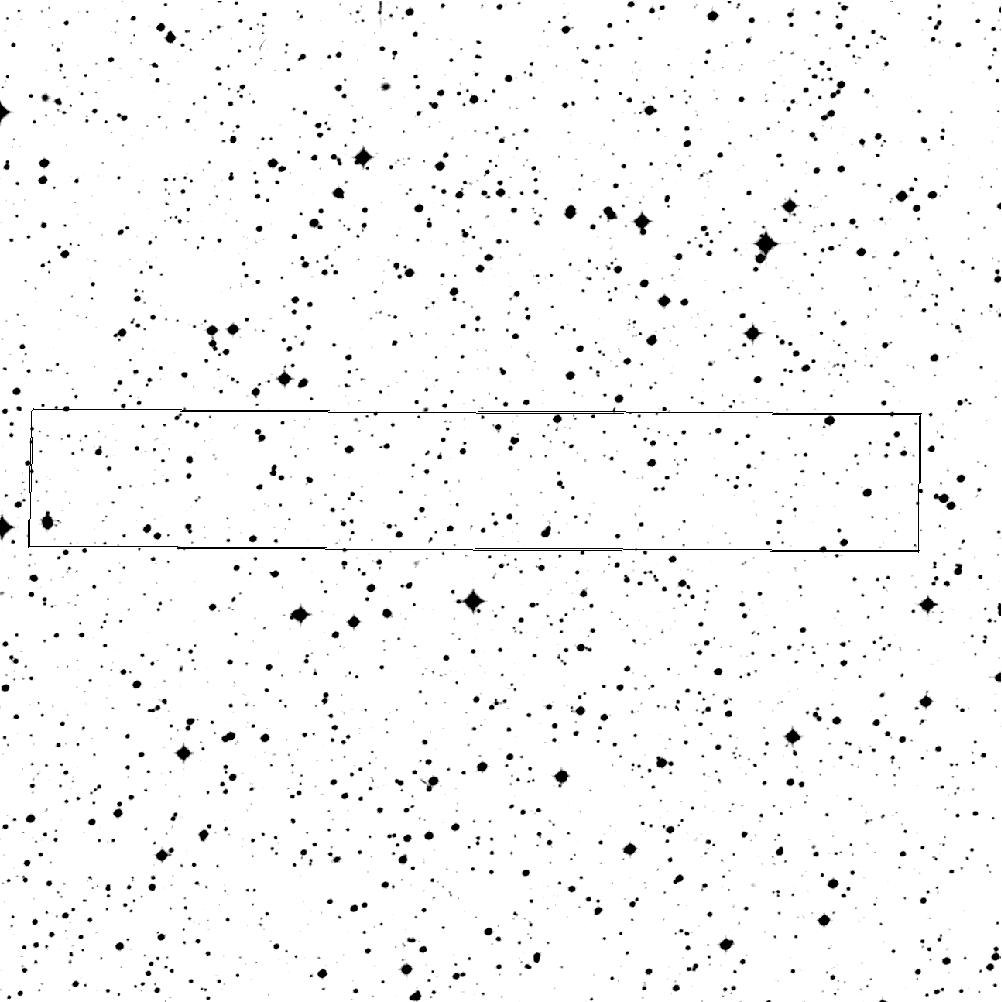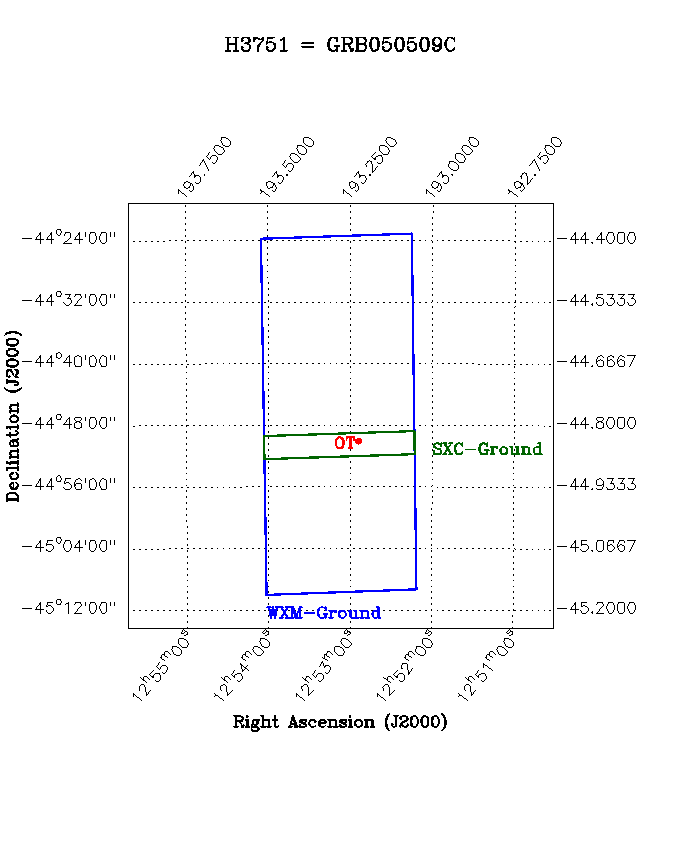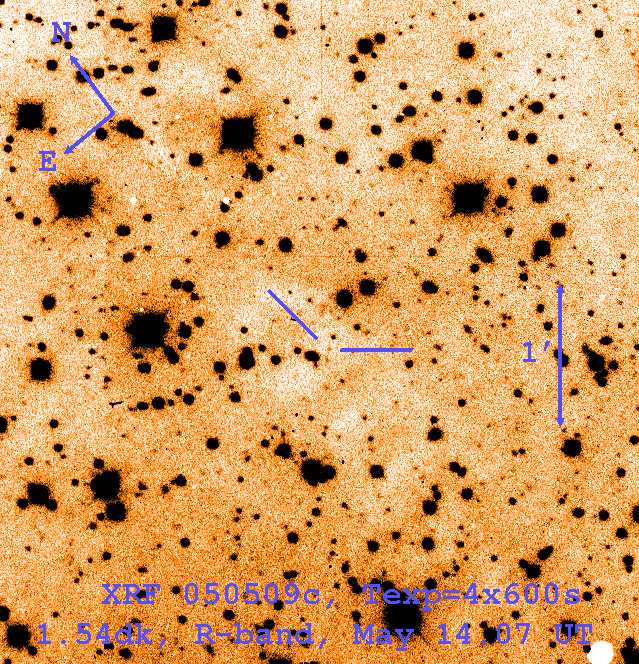- GCN/BACODINE POSITION NOTICE
TITLE: GCN/HETE BURST POSITION NOTICE
NOTICE_DATE: Mon 09 May 05 22:46:13 UT
NOTICE_TYPE: HETE S/C_Alert
TRIGGER_NUM: 3751, Seq_Num: 1
GRB_DATE: 13499 TJD; 129 DOY; 05/05/09
GRB_TIME: 81953.95 SOD {22:45:53.95} UT
TRIGGER_SOURCE: Trigger on the 2-30 keV band.
WXM_SIG/NOISE: 0.1 sig/noise on a 5.120 [sec] timescale
SC_-Z_RA: 197 [deg]
SC_-Z_DEC: -21 [deg]
SC_LONG: 52 [deg East]
WXM_CNTR_RA: 193.163d {+12h 52m 39s} (J2000),
193.239d {+12h 52m 57s} (current),
192.463d {+12h 49m 51s} (1950)
WXM_CNTR_DEC: -44.297d {-44d 17' 50"} (J2000),
-44.326d {-44d 19' 34"} (current),
-44.026d {-44d 01' 32"} (1950)
WXM_MAX_SIZE: 28.00 [arcmin] diameter
WXM_LOC_SN: 5 sig/noise (pt src in image)
WXM_IMAGE_SN: X= 4.0 Y= 3.7 [sig/noise]
WXM_LC_SN: X= 3.7 Y= 3.0 [sig/noise]
SUN_POSTN: 46.94d {+03h 07m 46s} +17.58d {+17d 34' 38"}
SUN_DIST: 141.11 [deg]
MOON_POSTN: 65.56d {+04h 22m 14s} +25.38d {+25d 22' 59"}
MOON_DIST: 133.99 [deg]
MOON_ILLUM: 3 [%]
GAL_COORDS: 303.16,18.57 [deg] galactic lon,lat of the burst
ECL_COORDS: 211.52,-35.16 [deg] ecliptic lon,lat of the burst
COMMENTS: Possible GRB.
COMMENTS: WXM error box is circular; not rectangular.
- GCN/BACODINE POSITION NOTICE
TITLE: GCN/HETE BURST POSITION NOTICE
NOTICE_DATE: Mon 09 May 05 22:46:16 UT
NOTICE_TYPE: HETE S/C_Update
TRIGGER_NUM: 3751, Seq_Num: 2
GRB_DATE: 13499 TJD; 129 DOY; 05/05/09
GRB_TIME: 81953.95 SOD {22:45:53.95} UT
TRIGGER_SOURCE: Trigger on the 2-30 keV band.
WXM_SIG/NOISE: 0.1 sig/noise on a 0.320 [sec] timescale
SC_-Z_RA: 197 [deg]
SC_-Z_DEC: -21 [deg]
SC_LONG: 52 [deg East]
WXM_CNTR_RA: 193.163d {+12h 52m 39s} (J2000),
193.239d {+12h 52m 57s} (current),
192.463d {+12h 49m 51s} (1950)
WXM_CNTR_DEC: -44.297d {-44d 17' 50"} (J2000),
-44.326d {-44d 19' 34"} (current),
-44.026d {-44d 01' 32"} (1950)
WXM_MAX_SIZE: 28.00 [arcmin] diameter
WXM_LOC_SN: 5 sig/noise (pt src in image)
WXM_IMAGE_SN: X= 4.0 Y= 3.7 [sig/noise]
WXM_LC_SN: X= 3.7 Y= 3.0 [sig/noise]
SUN_POSTN: 46.94d {+03h 07m 46s} +17.58d {+17d 34' 38"}
SUN_DIST: 141.11 [deg]
MOON_POSTN: 65.56d {+04h 22m 14s} +25.38d {+25d 22' 59"}
MOON_DIST: 133.99 [deg]
MOON_ILLUM: 3 [%]
GAL_COORDS: 303.16,18.57 [deg] galactic lon,lat of the burst
ECL_COORDS: 211.52,-35.16 [deg] ecliptic lon,lat of the burst
COMMENTS: Possible GRB.
COMMENTS: WXM error box is circular; not rectangular.
- GCN/BACODINE POSITION NOTICE
TITLE: GCN/HETE BURST POSITION NOTICE
NOTICE_DATE: Mon 09 May 05 22:50:21 UT
NOTICE_TYPE: HETE S/C_Last
TRIGGER_NUM: 3751, Seq_Num: 3
GRB_DATE: 13499 TJD; 129 DOY; 05/05/09
GRB_TIME: 81953.95 SOD {22:45:53.95} UT
TRIGGER_SOURCE: Trigger on the 2-30 keV band.
WXM_SIG/NOISE: 0.1 sig/noise on a 0.320 [sec] timescale
SC_-Z_RA: 197 [deg]
SC_-Z_DEC: -21 [deg]
SC_LONG: 52 [deg East]
WXM_CNTR_RA: 193.163d {+12h 52m 39s} (J2000),
193.239d {+12h 52m 57s} (current),
192.463d {+12h 49m 51s} (1950)
WXM_CNTR_DEC: -44.297d {-44d 17' 50"} (J2000),
-44.326d {-44d 19' 34"} (current),
-44.026d {-44d 01' 32"} (1950)
WXM_MAX_SIZE: 28.00 [arcmin] diameter
WXM_LOC_SN: 5 sig/noise (pt src in image)
WXM_IMAGE_SN: X= 4.0 Y= 3.7 [sig/noise]
WXM_LC_SN: X= 3.7 Y= 3.0 [sig/noise]
SUN_POSTN: 46.94d {+03h 07m 46s} +17.58d {+17d 34' 38"}
SUN_DIST: 141.11 [deg]
MOON_POSTN: 65.56d {+04h 22m 14s} +25.38d {+25d 22' 59"}
MOON_DIST: 133.99 [deg]
MOON_ILLUM: 3 [%]
GAL_COORDS: 303.16,18.57 [deg] galactic lon,lat of the burst
ECL_COORDS: 211.52,-35.16 [deg] ecliptic lon,lat of the burst
COMMENTS: Possible GRB.
COMMENTS: WXM error box is circular; not rectangular.
- red DSS finding chart
ps-file

- GCN/BACODINE POSITION NOTICE
TITLE: GCN/HETE BURST POSITION NOTICE
NOTICE_DATE: Tue 10 May 05 00:43:29 UT
NOTICE_TYPE: HETE Ground Analysis
TRIGGER_NUM: 3751, Seq_Num: 4
GRB_DATE: 13499 TJD; 129 DOY; 05/05/09
GRB_TIME: 81953.95 SOD {22:45:53.95} UT
TRIGGER_SOURCE: Trigger on the 2-30 keV band.
WXM_SIG/NOISE: 0.1 sig/noise on a 0.320 [sec] timescale
SC_-Z_RA: 196 [deg]
SC_-Z_DEC: -21 [deg]
SC_LONG: 52 [deg East]
WXM_CNTR_RA: 193.285d {+12h 53m 08s} (J2000),
193.360d {+12h 53m 26s} (current),
192.583d {+12h 50m 20s} (1950)
WXM_CNTR_DEC: -44.776d {-44d 46' 32"} (J2000),
-44.805d {-44d 48' 16"} (current),
-44.504d {-44d 30' 15"} (1950)
WXM_CORNER1: 193.0640 -44.3850 [deg]
WXM_CORNER2: 193.5209 -44.3960 [deg]
WXM_CORNER3: 193.5070 -45.1670 [deg]
WXM_CORNER4: 193.0470 -45.1550 [deg]
WXM_MAX_SIZE: 50.57 [arcmin] diameter
WXM_LOC_SN: 3 sig/noise (pt src in image)
WXM_IMAGE_SN: X= 6.1 Y= 4.8 [sig/noise]
WXM_LC_SN: X= 7.5 Y= 6.5 [sig/noise]
SXC_CNTR_RA: 193.283d {+12h 53m 08s} (J2000),
193.359d {+12h 53m 26s} (current),
192.581d {+12h 50m 19s} (1950)
SXC_CNTR_DEC: -44.843d {-44d 50' 32"} (J2000),
-44.872d {-44d 52' 16"} (current),
-44.571d {-44d 34' 15"} (1950)
SXC_CORNER1: 193.5120 -44.8730 [deg]
SXC_CORNER2: 193.0530 -44.8620 [deg]
SXC_CORNER3: 193.0550 -44.8120 [deg]
SXC_CORNER4: 193.5130 -44.8230 [deg]
SXC_MAX_SIZE: 19.78 [arcmin] diameter
SXC_LOC_SN: 3 sig/noise (pt src in image)
SUN_POSTN: 46.94d {+03h 07m 46s} +17.58d {+17d 34' 38"}
SUN_DIST: 140.89 [deg]
MOON_POSTN: 65.56d {+04h 22m 14s} +25.38d {+25d 22' 59"}
MOON_DIST: 134.02 [deg]
MOON_ILLUM: 3 [%]
GAL_COORDS: 303.25,18.03 [deg] galactic lon,lat of the burst
ECL_COORDS: 211.93,-35.60 [deg] ecliptic lon,lat of the burst
COMMENTS: Definite GRB.
COMMENTS: Possible GRB.
COMMENTS: Burst_Validity flag is true.
COMMENTS: WXM data refined since S/C_Last Notice.
COMMENTS: SXC data refined since S/C_Last Notice.
- GCN notice #3400
P. D'Avanzo, S. Piranomonte, L.A. Antonelli, S. Covino, F.M. Zerbi, G.
Chincarini, M. Rodono', G. Tosti, P. Conconi, G. Cutispoto, E.
Molinari, L. Nicastro, E. Palazzi, V. Testa, F. Vitali, E. Meurs, P.
Goldoni, on behalf of the REM/ROSS Team report:
"We imaged the central part of the field of GRB050509 with the robotic
60-cm REM telescope located at La Silla, Chile. REM is equipped with
the REMIR near infrared camera (10x10 sq arcmin FoV, JHK filters) and
the ROSS optical spectrograph/imager (10x10 sq arcmin FoV, VRI filters
and AMICI prism).
Observations of GRB 050509 were performed in fully automated mode
simultaneously in the near infrared and in the optical starting
approximately 56 seconds after the burst (32 seconds after the
reception of the burst alert). Then, 2 hrs after the burst, REM
performed automatically a further observation of the refined position
of GRB 050509 few seconds after the new trigger delivered by the HETE
Team.
A preliminary analysis of both the H and R band images does not reveal
any new object down to the 2MASS and DSS limits respectively."
This message may be cited.
- GCN notice #3402
GRB050509c (=H3751): An X-Ray Flash Localized By HETE
G. Prigozhin, G. Ricker, J-L. Atteia, N. Kawai, D. Lamb,
and S. Woosley, on behalf of the HETE Science Team;
M. Arimoto, T. Donaghy, E. Fenimore, M. Galassi, C. Graziani,
J. Kotoku, M. Maetou, M. Matsuoka, Y. Nakagawa, T. Sakamoto, R. Sato,
Y. Shirasaki, M. Suzuki, T. Tamagawa, K. Tanaka, Y. Yamamoto,
and A. Yoshida, on behalf of the HETE WXM Team;
N. Butler, G. Crew, J. Doty, R. Vanderspek, J. Villasenor,
J. G. Jernigan, A. Levine, G. Azzibrouck, J. Braga, R. Manchanda,
and G. Pizzichini, on behalf of the HETE Operations and HETE
Optical-SXC Teams;
M. Boer, J-F Olive, J-P Dezalay, and K. Hurley, on behalf of the HETE
FREGATE Team;
report:
The HETE FREGATE, WXM, and SXC instruments detected GRB 050509c at
22:45:54 UT (81953.95 SOD) on 9 May 2005. This was a weak burst
consisting of a single pulse ~25 s long, with almost no emission above
18 keV in the WXM.
The WXM flight localization can be expressed as a circle of radius 14
arcminutes (90% confidence) that is centered at
WXM-Flight: RA = 12h 52m 39s, Dec =-44d 17' 50" (J2000).
The first flight localization was distributed in a GCN Notice issued
at 22:46:13 UT, 19 s after the burst trigger.
Ground analysis of the WXM data produced a refined WXM localization
that was in a GCN Notice issued 10 May 05 at 00:43:29 UT. This ground
WXM localization can be expressed as a rectangle with corners:
R.A. = 12 52 15.4 ; Dec. = -44 23 06
R.A. = 12 54 05.0 ; Dec. = -44 23 46
R.A. = 12 54 01.7 ; Dec. = -45 10 01
R.A. = 12 52 11.3 ; Dec. = -45 09 18 (J2000).
The burst was also detected by the SXC Y camera. Ground analysis of
the SXC data produced a long thin rectangle. Truncating the rectangle
by the WXM ground localization results in a rectangle with corners:
R.A. = 12 54 02.9 ; Dec. = -44 52 23
R.A. = 12 52 12.7 ; Dec. = -44 51 43
R.A. = 12 52 13.2 ; Dec. = -44 48 43
R.A. = 12 54 03.1 ; Dec. = -44 49 23 (J2000).
A preliminary spectral analysis indicates that Epk < 19 keV. The
preliminary fluences are: S(2-30 keV) = 6E-07 erg cm^-2,
S(30-400) = 3E-07 erg cm^-2. Therefore GRB 050509c is an X-ray flash.
A light curve, skymap, and spectral information for GRB 050509c are
provided at the following URL:
http://space.mit.edu/HETE/Bursts/GRB050509C/

- GCN notice #3404
L.A. Antonelli on behalf of the REM/ROSS Team report:
Please, note that GCN 3400 (D'Avanzo et al.) having subject
"GRB050509: REM NIR and Optical observations" is referring to GRB
050509c.
Thanks to Alberto Castro-Tirado and Nicola Masetti to point out the
misleading subject.
- GCN notice #3406
E.S. Rykoff (U Mich), H. Swan (U Mich), R. Quimby (U Texas), T.A. McKay
(U Mich), report on behalf of the ROTSE collaboration:
ROTSE-IIIc, located at the H.E.S.S. site at Mt. Gamsberg, Namibia,
responded to GRB 050509c (HETE trigger 3751), producing images beginning
6.4 s after the GCN notice time. An automated response took the first
image at 22:46:19.6 UT, 25.7 s after the burst, under excellent
conditions. We took 10 5-sec, 10 20-sec and 120 60-sec eposures. These
unfiltered images are calibrated relative to USNO A2.0 (R). The final
error box reported by Prigozhin et al. (GCN 3402) was entirely contained
within the ROTSE-IIIc field of view of the initial response.
Comparison to the DSS (second epoch) reveals no new sources within the
SXC/WFC error box reported in GCN 3402; however, we are limited as the
field is somewhat crowded. Individual images have limiting magnitudes
ranging from 15.8-17.1. In particular, we set a limit of magnitude 15.9
in a single 5 s exposure, starting 25.7 s after the burst. Coadding the
images into sets of 10 reveals no new sources down to limits of 17.0
(136 s effective length (t_end-t_start), beginning 25.7 s post-burst),
17.5 (295.4 s effective length, beginning 170.7 s post-burst), and 17.7
(695 s effective length, beginning 466.1 s post-burst).
- GCN notice #3425
J. Gorosabel (IAA-CSIC), B. L. Jensen (NBI), G. Galaz (Pont. Uni. de Chil=
e),
R. Salinas (Uni. de Concepcion), J. Hjorth, J. P. U. Fynbo, H. Pedersen,
D. Watson, P. Jakobsson, J. M. Castro Cer=F3n (NBI), report:
"We have carried out R-band observations of XRF 050509c (HETE trigger #37=
51;=20
GCN 3402) error box with the 1.54m Danish telescope (+DFOSC) on La Silla,=
=20
as follows:
Date UT t-to Texp Seeing =20
May 2005 (hr) (s) (") =20
--------------------------------------
10.1545-10.1703 5.1 2x600 1.2
14.0490-14.0829 98.8 4x600 1.3
Both observations are centred in the SXC error box covering ~80% of it.=20
Comparison of the two epoch images reveals, well centred in the SXC error=
=20
box, a fading point-like object with coordinates:
RA(J2000) =3D 12:52:53.94=20
Dec(J2000) =3D -44:50:04.1 (internal astrometric error of 1")
which we propose as the XRF 050509c optical afterglow.
Assuming R =3D 17.9 for the USNO star placed at (12:52:52.34, -44:49:23.1=
)
we estimate a decay from R~20.1 to R~24.0 between the two epochs. This
would imply a power-law decay index of -1.2 typical of GRB afterglows.
Finding charts can be found at:
http://www.dsri.dk/~jgu/grb050509c/FCs/grb050509c.1.54dk.epoch1.gif
http://www.dsri.dk/~jgu/grb050509c/FCs/grb050509c.1.54dk.epoch2.gif
Further observations are planned."


- GCN notice #3427
S. Piranomonte, P. D'Avanzo, L.A. Antonelli, S. Covino, D. Malesani,
F.M. Zerbi, G. Chincarini, M. Rodono', G. Tosti, P. Conconi, G.
Cutispoto, E. Molinari, L. Nicastro, E. Palazzi, V. Testa, F. Vitali, E.
Meurs, P. Goldoni, on behalf of the REM/ROSS Team report:
Following the detection of a candidate optical counterpart for XRF
050509c (HETE trigger #3751; GCN 3402), by Gorosabel et al. (GCN 3425)
we re-analyzed our optical and NIR REM data (D'Avanzo et al GCN 3400).
At 2.5 hours after the burst no object is found at the position of the
candidate down to a limiting magnitude of R=19 and H=15.5 (3-sigma
level). We note that our R limit is consistent with a power-law decay
index of -1.2 (Gorosabel et al. GCN 3425).
This message may be cited.
- GCN notice #3440
A. M. Soderberg (Caltech) and D. A. Frail (NRAO) report on behalf of
the Caltech-NRAO-Carnegie collaboration:
"We observed the field of XRF050509c (GCN 3402) with the Very Large
Array at 8.5 GHz on May 20.17 UT. We do not detect a radio source
coincident with the OT position (GCN 3425). We place a 2-sigma upper
limit of 104 uJy."
- GCN notice #3441
S. Campana (INAF-OAB), C. Pagani (INAF-OAB, PSU), D.N. Burrows (PSU)
and N. Gehrels (NASA/GSFC) report on behalf of the Swift XRT team:
The Swift XRT observed the HETE II burst XRF 050509c for ~4ks from
07:00 UT to 21:35 UT on 18 May 2005 and for ~19 ks from 00:18 UT to 23:25 UT
on 19 May 2005.
We did not detect any source in either observation in a 20
arcsec radius circle centred at the position of the optical counterpart
identified by Gorosabel et al 2005 (GCN 3425). Combining data from the two
observations, we obtain 23.1 ks of good data after normal data screening.
The 3 sigma upper limit on the count rate is of 8.4e-4 counts/s
(0.2-10.0 keV).
Assuming a Crab-like spectrum and a Galactic column of 7.1e20 cm-2, this
corresponds to an upper limit on the unabsorbed flux of ~3e-14
ergs/cm2/s (0.5-10.0 keV).
- GCN notice #3442
Derek B. Fox (Caltech) reports on behalf of a larger collaboration:
"We have observed the afterglow (Gorosabel et al, GCN 3425) of XRF
050509C (Prigozhin et al., GCN 3402) with the Chandra X-ray
Observatory and ACIS-S detector, in a single 20-ks pointing beginning
at 09:54 UT on May 19, and detect the X-ray afterglow at a count rate
of 0.7(2) counts per ksec. This count rate corresponds to a 0.5-10
keV flux of 9E-15 erg cm-2 s-1, assuming a spectrum with power-law
photon index alpha=1.5 and Galactic N_H=5.5E+20 cm-2. We note that
this flux is consistent with the upper limit from Swift XRT at a
similar epoch (Campana et al., GCN 3441)."
- GCN notice #3543
P. B. Cameron and A. M. Soderberg (Caltech) report on behalf
of the Caltech-NRAO-Carnegie collaboration:
"We observed the field of XRF050509c (GCN 3402) with the
Very Large Array at 8.5 GHz on Jun 8.13 UT. At the position of
the optical afterglow (GCN 3425) we detect a radio source
with flux density 310 +- 49 uJy. Further observations are
planned."
- GCN notice #3546
J. Gorosabel (IAA-CSIC), J. Hjorth, B. L. Jensen, U. G. J=F8rgensen (NBI)=
,
J.-P. Beaulieu, A. Cassan (IAP), M. I. Andersen (AIP),
J. Donatowicz (Tech. Uni. of Vienna), D. Watson, J. P. U. Fynbo,
P. Jakobsson, J. M. Castro Cer=F3n, H. Pedersen (NBI), report:
"We have performed almost daily R-band monitoring of the XRF 050509c
field (GCN Circ. 3402, HETE-2 trigger #3751) from May 15 to June 8.
No significant rebrightening brighter than R ~ 22.5 has been detected at
the afterglow position (GCN Circ. 3425) during the mentioned period.
If XRF 050509c was related to a supernova similar to SN 1998bw, our
observations would imposse a lower redshift limit of z > 0.4.
A combination of all late images=20
(www.astro.ku.dk/~brian_j/grb/grb050509.95/)
reveals a faint (R ~ 24) object coincident with the afterglow position,
which we tentatively identify as the host galaxy of XRF 050509c."
- GCN notice #3861
Atish Kamble (Raman Research Institute [RRI], Bangalore, India),
C. H. Ishwara Chandra (NCRA, Pune, India) and D. Bhattacharya (RRI)
report on behalf of a larger GRB collaboration :
We observed the field of XRF 050509c (GCN 3402, GCN 3425, GCN 3543)
on Jul. 6.56 (UT) and on Aug 4.48 (UT) with the Giant Meterwave Radio
Telescope (GMRT), India at 1280 MHz using a bandwidth of 32 MHz.
We do not detect any source coincident with the position of radio
afterglow reported by Cameron and Soderberg (GCN 3543).
The two sigma upper limits are as follows:
Jul. 6.56 (UT) : 0.22 mJy
Aug 4.48 (UT) : 0.12 mJy
We thank GMRT and the National Centre for Radio Astrophysics (NCRA) staff.
This TOO was done under the GMRT Director's Discretionary Time.
GMRT is run by NCRA-TIFR, Pune (INDIA).
This messege may be cited.
![]() Previous IAU Circulars
Previous IAU Circulars 


